Overview
The article delineates ten significant benefits of urban distributed energy storage systems, underscoring their pivotal role in enhancing energy reliability, reducing costs, and facilitating the integration of renewable energy sources. These points are bolstered by evidence illustrating how these systems improve grid stability, lower carbon footprints, and create local jobs. Consequently, they are transforming urban energy landscapes into more resilient and sustainable environments.
Introduction
In the quest for sustainable urban energy solutions, distributed energy storage systems are emerging as transformative agents, reshaping how cities manage their energy needs. These innovative technologies not only enhance energy reliability and reduce costs but also facilitate the integration of renewable energy sources, such as solar and wind.
As urban areas grapple with the challenges of fluctuating energy demands and the imperative to lower carbon footprints, the role of distributed energy storage becomes increasingly critical. By empowering communities and fostering local energy independence, these systems pave the way for a resilient energy future, ultimately supporting economic growth and environmental sustainability.
As cities embark on this journey, understanding the strategic implications of distributed energy storage will be essential for navigating the complexities of urban energy landscapes.
Harbinger Land: Comprehensive Solutions for Land Services in Energy and Infrastructure
Harbinger Land excels in delivering tailored land services that are essential for power and infrastructure projects across the United States. Their comprehensive offerings include:
- Site and right-of-way acquisition
- Title research
- GIS mapping
- Advanced data processing
By leveraging integrated GIS modeling services, Harbinger Land efficiently negotiates and acquires the necessary leases and easements for distributed resource systems (DER) and infrastructure development. This approach significantly enhances operational efficiency and client satisfaction. It ensures that natural gas firms, solar project developers, and local governments receive prompt and accurate services, which are crucial for the effective implementation of distributed power solutions in urban areas.
Current statistics reveal that the average distance from city-based distributed power facilities to the nearest protected area presents considerable challenges for land acquisition. Many developers face delays due to complex regulatory requirements. Comprehensive land services not only streamline these processes but also bolster project viability by ensuring compliance with zoning regulations and environmental considerations. The integration of technology in land services has transformed the landscape of power infrastructure, allowing for more precise data processing and mapping—elements that are vital for urban distributed energy storage systems. Harbinger Land's document imaging solutions further enhance the efficiency of title research and leasing, providing quick access to extensive datasets necessary for informed decision-making regarding urban distributed energy storage systems.
As illustrated in the case study on the Food-Water Nexus in California, effective land management strategies that consider the interconnections between food production, power generation, and water resources are paramount for sustainable development. This case study underscores the importance of comprehensive land services in overcoming the challenges of land acquisition for power projects.
Rebecca R. Hernandez from the Department of Global Ecology at the Carnegie Institution for Science emphasizes the need for integrated approaches to land management, asserting that such strategies are essential for balancing competing demands in infrastructure. Harbinger Land remains at the forefront of providing innovative land services that tackle the unique challenges of urban power infrastructure, reaffirming their commitment to supporting sustainable power solutions.
Environmental Sustainability: Reducing Carbon Footprint with Urban Distributed Energy Storage
Urban distributed energy storage systems play a pivotal role in significantly reducing carbon emissions and promoting the integration of renewable sources such as solar and wind. By effectively harnessing surplus power generated during peak production periods, urban distributed energy storage systems can provide stored energy during times of high demand, thereby diminishing reliance on fossil fuels. This transition not only supports sustainability goals but also plays a critical role in mitigating the impacts of climate change.
Data indicates that the utilization of compressed air power conservation can lead to a reduction in carbon dioxide emissions by 40 to 60 percent, contingent upon the specific configuration. Furthermore, the combination of solar power with urban distributed energy storage systems addresses the limitations of solar generation during non-sunny periods, optimizing efficiency and yielding substantial cost savings while lowering dependence on fossil fuels. Successful implementations of urban distributed energy storage systems have shown their effectiveness in decreasing carbon footprints. For instance, the integration of solar and battery systems has been shown to enhance community resilience and reduce greenhouse gas emissions, aligning with the objectives set forth by the US Department of Energy.
These advancements not only contribute to environmental sustainability but also influence land acquisition strategies in urban planning, as decision-makers increasingly recognize the benefits of incorporating renewable solutions into their initiatives. As cities continue to adopt these innovative solutions, the potential for urban distributed energy storage systems to transform consumption patterns and facilitate the integration of renewable resources becomes increasingly evident.
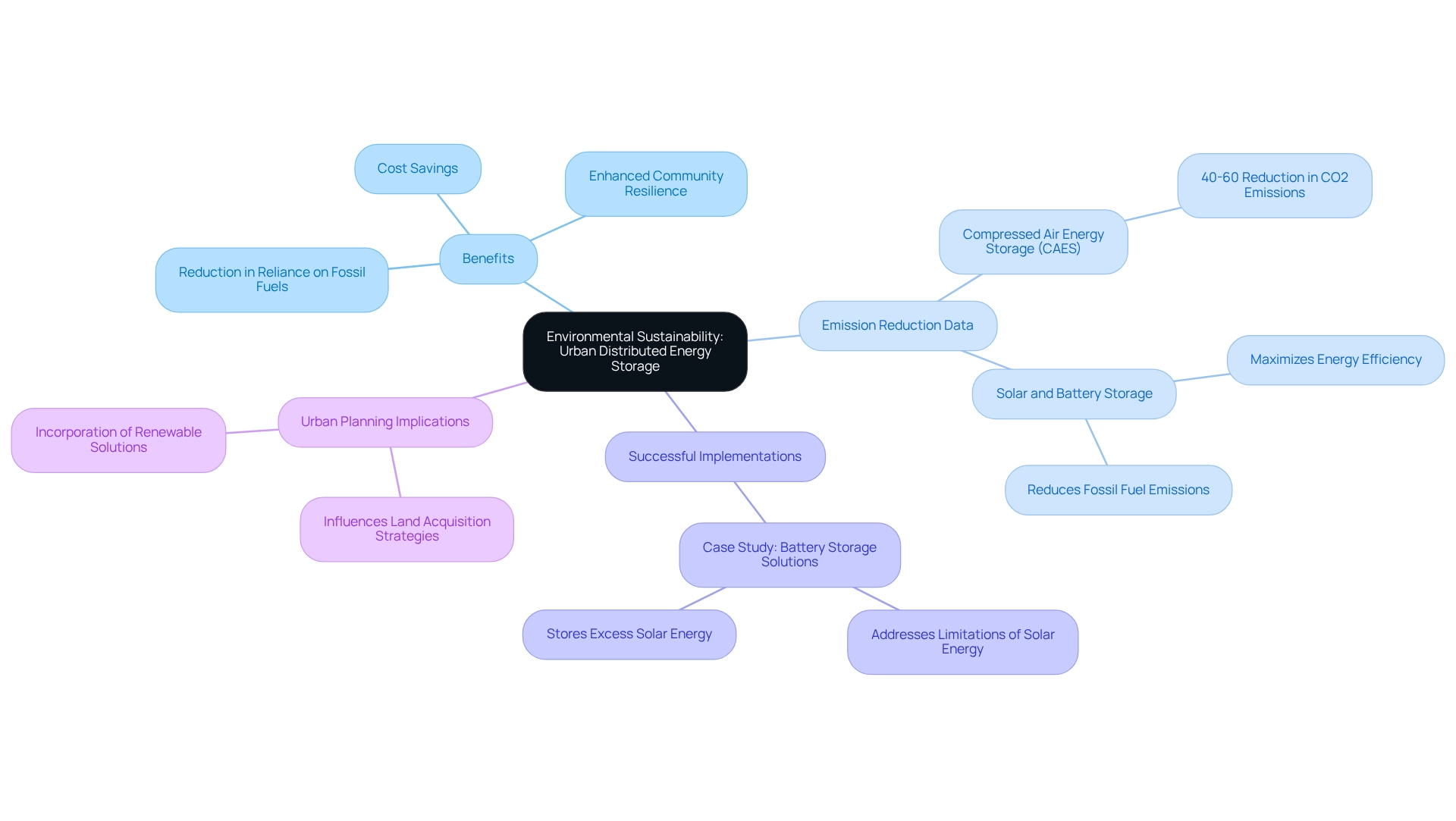
Cost Efficiency: Lowering Energy Costs through Urban Distributed Energy Storage
Urban distributed energy storage systems present a compelling opportunity for consumers and businesses to significantly reduce costs. By strategically storing power during off-peak hours—when prices are lower—and discharging it during peak hours, urban distributed energy storage systems effectively flatten costs. This approach not only diminishes the need for expensive peak power facilities but also leads to substantial overall savings in utility expenses by utilizing urban distributed energy storage systems. Such cost efficiency is particularly beneficial for municipalities and businesses striving to optimize their budget allocations.
As you consider the financial implications of energy consumption, how can these solutions transform your operational strategy?

Energy Reliability: Enhancing Grid Stability with Urban Distributed Energy Storage
Distributed power storage solutions are essential for enhancing grid reliability, providing crucial backup power during outages and stabilizing fluctuations in supply and demand. These urban distributed energy storage systems act as a buffer, absorbing surplus power during low usage and releasing it during peak demand, effectively preventing blackouts and ensuring a consistent power supply. This capability is particularly critical in metropolitan areas, where urban distributed energy storage systems can help manage highly unpredictable power consumption.
Recent advancements in power retention technologies, such as advanced lead-acid and lithium-ion batteries, have significantly improved grid reliability. Distributed systems contribute to a more resilient infrastructure. By 2025, urban distributed energy storage systems have resulted in substantial enhancements in urban power reliability, mitigating the risk of power outages while also supporting the integration of renewable energy sources.
As Jonah Steinbuck, Director of the Research and Development Division at the California Energy Commission, articulates, "As we advance new power technologies and tools, we want to see benefits delivered to communities in air quality and health, affordable and equitable access to clean technology, and new jobs and industries that can drive a sustainable economy."
Furthermore, the collaboration between Hitachi and Penske on sustainable truck fleet charging exemplifies the practical applications of power management solutions in reducing carbon footprints. As urban areas continue to grow, the establishment of urban distributed energy storage systems will be vital for maintaining a stable and reliable grid, ultimately fostering a sustainable energy future.
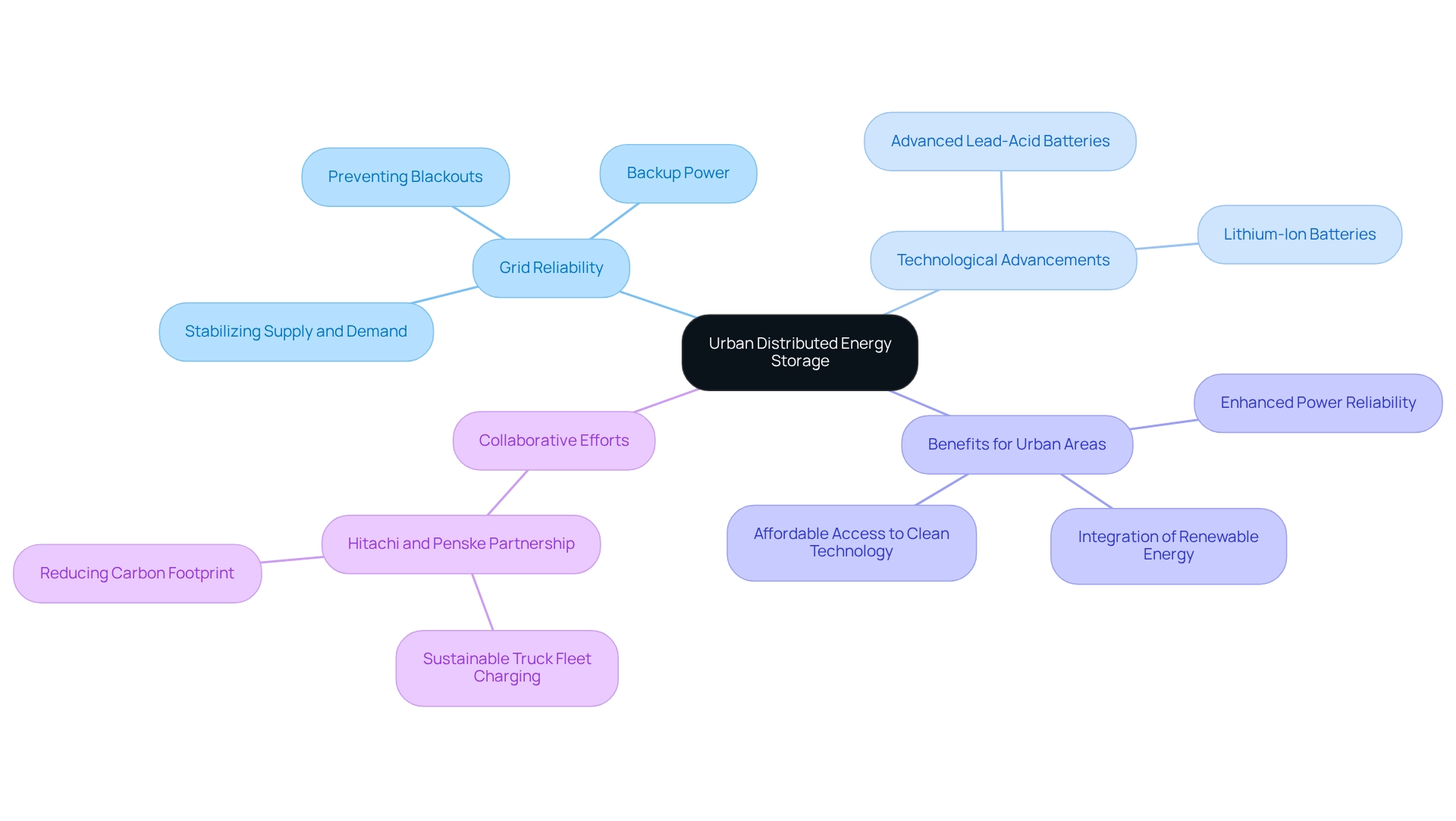
Renewable Integration: Facilitating the Use of Solar and Wind Energy in Urban Areas
Urban distributed energy storage systems are vital for seamlessly integrating renewable energy sources, particularly solar and wind. By effectively capturing and storing power generated from these intermittent resources, these systems ensure that renewable energy remains available even during periods of low production. This capability is crucial for transitioning to a cleaner power grid, as it addresses the challenges posed by fluctuations in renewable generation.
As of 2025, the capacity for renewable power generation has reached unprecedented levels, with solar and wind comprising a significant portion of urban power portfolios. Recent statistics indicate that solar and wind power now account for over 40% of total power generation in city regions. However, integrating these sources into existing infrastructure presents challenges, including the need for sophisticated solutions to efficiently manage supply and demand.
Successful city initiatives have demonstrated that power retention significantly enhances the reliability of solar and wind energy. For example, the case study titled "Long-term Resilience in Embassy Design" illustrates how innovative sustainability approaches can be effectively implemented in urban environments. Cities that have adopted urban distributed energy storage systems report improved resilience against power fluctuations, leading to a more stable power supply. Experts emphasize that power retention is not merely a backup option; it is an essential component that enables the broader adoption of renewable technologies. Curtis F. Clay, Director of Architecture in the State Department’s Bureau of Overseas Buildings Operations, stated, "The final Embassy 2050 report has surpassed our expectations and now the challenging task of implementation starts," underscoring the importance of innovation in power frameworks.
In conclusion, urban distributed energy storage systems play an indispensable role in facilitating the integration of solar and wind energy, as they enhance the effectiveness of urban power networks while supporting sustainability objectives. As cities continue to evolve into hubs of innovation, the implementation of advanced power retention solutions will be critical for achieving a robust and sustainable future for energy resources. Urban areas are pivotal to the future of global population management and sustainability, further reinforcing the case for urban distributed power solutions.

Technological Innovation: Smart Solutions for Urban Distributed Energy Storage
Recent technological advancements have revolutionized intelligent distributed power retention frameworks, significantly enhancing power management capabilities. By leveraging artificial intelligence and machine learning algorithms, these platforms can accurately forecast power requirements and dynamically adjust storage and discharge cycles. This optimization not only maximizes efficiency but also elevates the overall performance of urban distributed energy storage systems, making them more responsive to real-time resource needs.
A notable example is a newly developed framework for low voltage standard testing, which has demonstrated improved power management through machine learning, outpacing traditional methods. Evaluation metrics such as MSE, MAE, and RMSE quantitatively assess the framework's accuracy, revealing lower values compared to other models. Consequently, the adoption of renewable power sources has surged by 12%, underscoring the tangible benefits of these innovations.
Furthermore, urban distributed energy storage systems that utilize AI-facilitated predictive maintenance strategies reduce downtime and lower repair costs, thereby enhancing the overall efficiency of city power networks. As highlighted by The Pecan Team:
- "Businesses can significantly lower expenses and promote environmental sustainability by optimizing power consumption,"
which emphasizes the critical role of urban distributed energy storage systems in advancing urban power infrastructure.
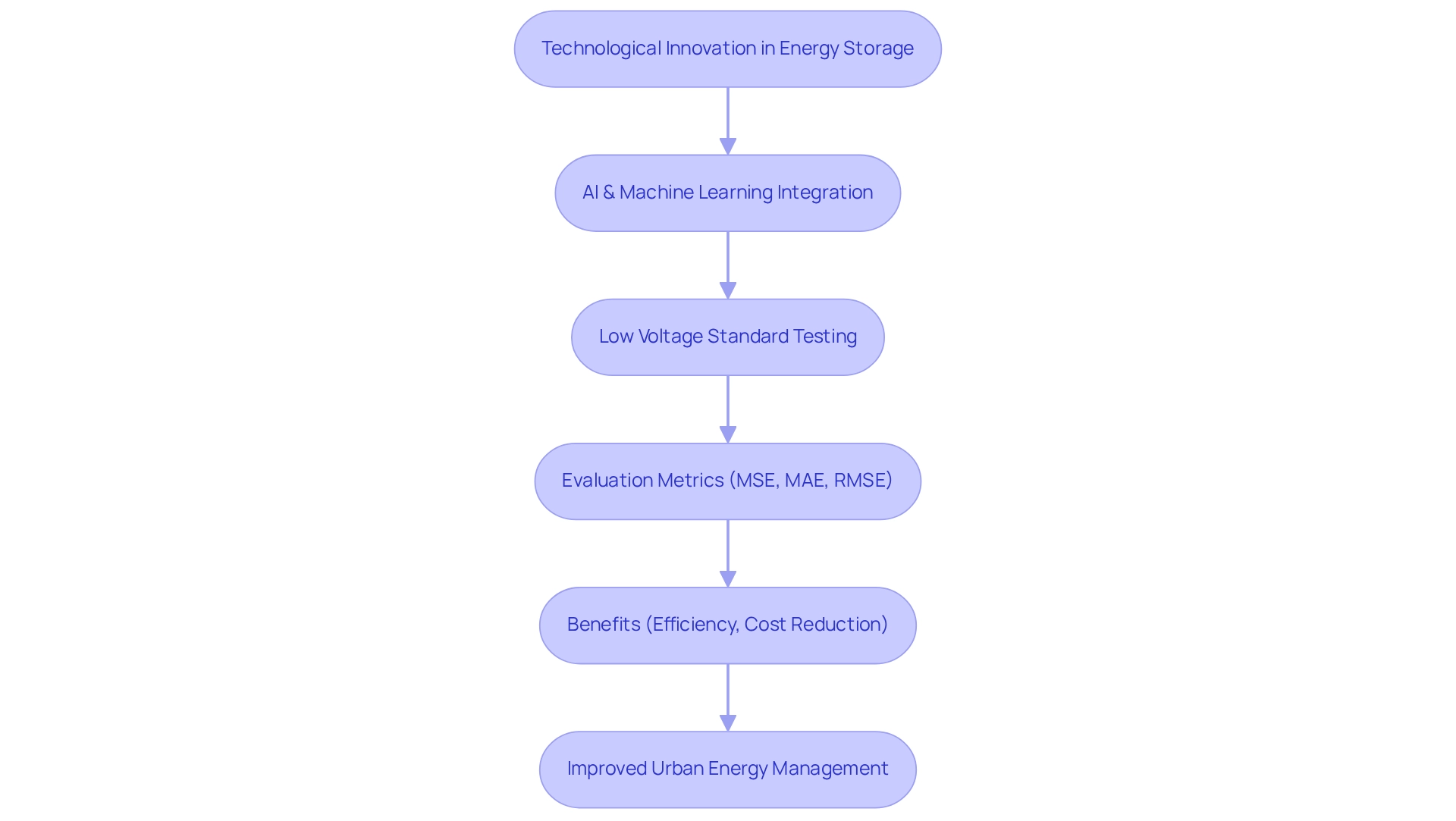
Community Empowerment: Promoting Local Energy Independence with Distributed Storage
Urban distributed energy storage systems are essential in empowering communities by enhancing local autonomy. By utilizing urban distributed energy storage systems to produce and store their own power, communities can significantly reduce their reliance on centralized grids, which in turn improves their resilience against price fluctuations and potential outages. This localized control over power resources fosters a sense of ownership among residents and encourages sustainable practices while promoting active involvement in resource management through urban distributed energy storage systems.
Recent statistics from the EDU Offshore Wind Fair reveal that communities utilizing urban distributed energy storage systems experience improved economic performance, as these systems enable them to manage their power usage and expenses more effectively. A case study titled "Impact of Tariffs on Self-Consumption Rates" illustrates how changes in tariffs in Spain have led to increased self-consumption rates, providing financial benefits to local power communities.
Moreover, expert opinions underscore the importance of community empowerment through urban distributed energy storage systems for achieving resource independence. As Alexandre Roussel, a former energy analyst, noted, "Better access to financing and support, regulatory reforms, and sharing of experiences could give communities around the world greater access to local, clean and affordable resources." This statement emphasizes the need for supportive structures to enable communities to achieve local power solutions.
As communities engage in urban distributed energy storage systems for local resource management, they not only gain control over their assets but also contribute to broader sustainability objectives. Future regulations may allow for variable coefficients that could adjust power sharing based on hourly demand, further enhancing local resource management. Initiatives that leverage urban distributed energy storage systems demonstrate how local power autonomy can yield significant community benefits, including increased resilience, economic stability, and a stronger commitment to sustainable practices.
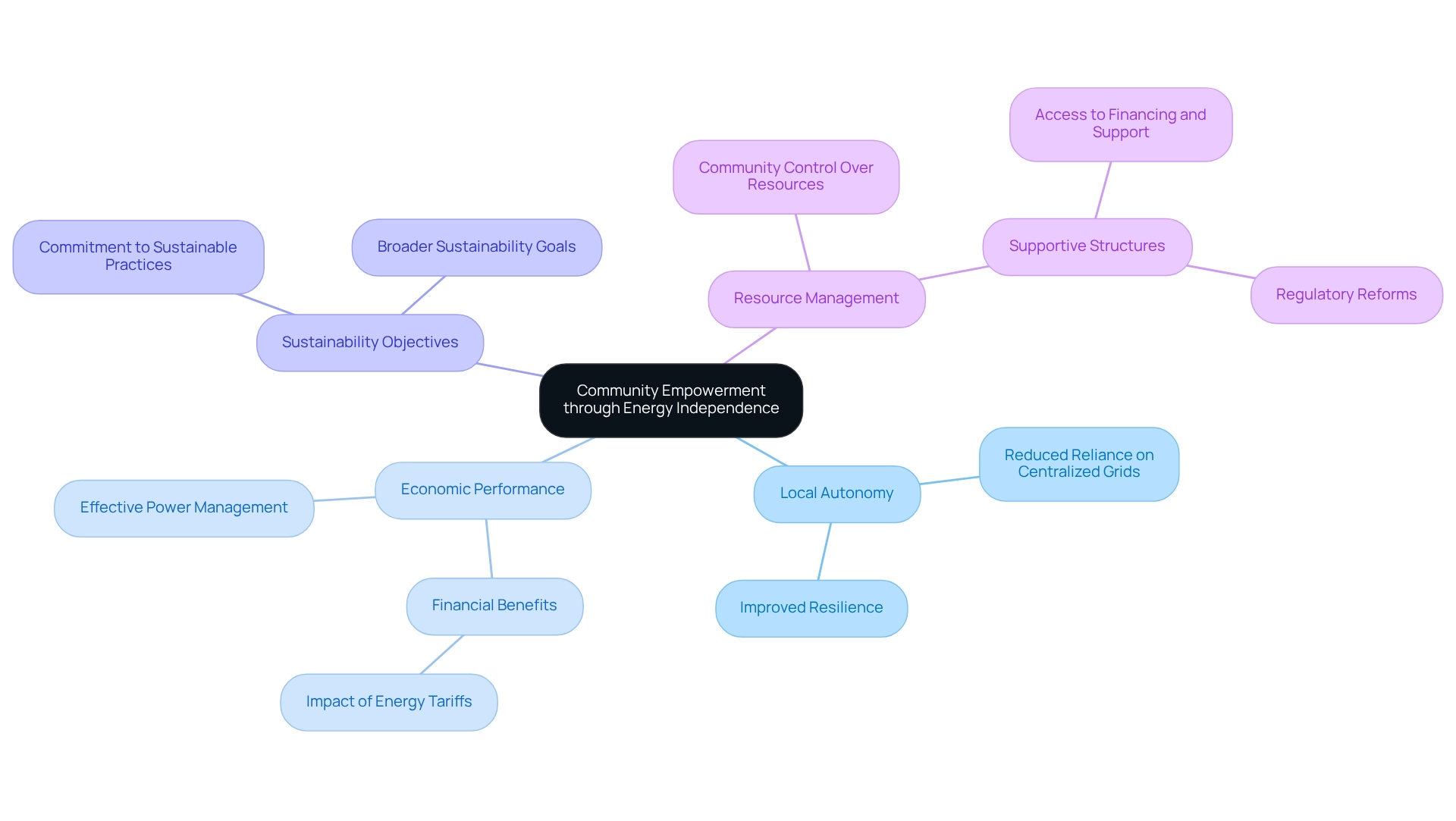
Regulatory Support: Navigating Policies for Urban Distributed Energy Storage Implementation
Navigating the regulatory environment is essential for the successful execution of urban distributed energy storage systems. Supportive policies and incentives are pivotal in facilitating the adoption of these technologies, as they minimize financial barriers and expedite permitting processes. For instance, the California Public Utilities Commission (CPUC) initiated a rulemaking in December 2010, establishing a procurement goal of 1,325 megawatts for power retention systems, significantly influencing deployment strategies. Collaboration with local and state authorities to promote supportive policies is vital for stakeholders aiming to implement distributed power solutions effectively.
Recent advancements in regulatory structures highlight the growing recognition of the need for assistance in power integration. As Isabel María Alvarez-Rodriguez noted, understanding the benefits of power preservation is contingent upon establishing regulatory frameworks that foster appealing business models. Therefore, comprehending and navigating these regulations is crucial for enhancing the adoption of urban distributed energy storage systems.
Additionally, a webinar discussing current research findings on regulatory support is scheduled for April 23, offering further insights for decision-makers in this field. Are you ready to engage with these regulatory challenges and leverage the opportunities they present?
Job Creation: Boosting Local Economies through Urban Distributed Energy Storage Projects
Urban distributed power projects play a pivotal role in revitalizing local economies by generating job opportunities in installation, maintenance, and operation. As communities embrace these innovative technologies, they bolster their power resilience and stimulate economic growth within the clean power sector. Recent data indicates that the clean power sector has seen substantial job expansion, with projections suggesting that city-based distributed power initiatives could create thousands of positions by 2025. Specifically, it is expected that the clean power sector will generate approximately 1.3 million jobs in the United States by 2030, underscoring the significant potential of these initiatives.
This surge in employment not only boosts local spending but also enhances community well-being. Notably, case studies reveal that cities like San Diego and New York, which have adopted these initiatives, have experienced marked economic improvements, showcasing the transformative power of distributed energy resources in fostering sustainable urban growth. For instance, San Diego's investment in power storage has led to a 20% reduction in costs for residents, highlighting the financial benefits of these initiatives.
As the demand for clean power solutions continues to rise, the economic impact of these initiatives is poised to expand, reinforcing their critical role in local economies. Furthermore, according to IRENA and CPI, renewables have benefited from strong investor interest and growing awareness among policymakers regarding climate change, resource security, and stable domestic power sources. The avoided externalities from the 1.5°C Scenario are projected to range from USD 508 billion to USD 1,580 billion cumulatively by 2050, further emphasizing the financial implications of adopting such technologies. As innovative applications in this sector progress, urban distributed energy storage systems will play a crucial role in meeting diverse power needs and fostering economic development.
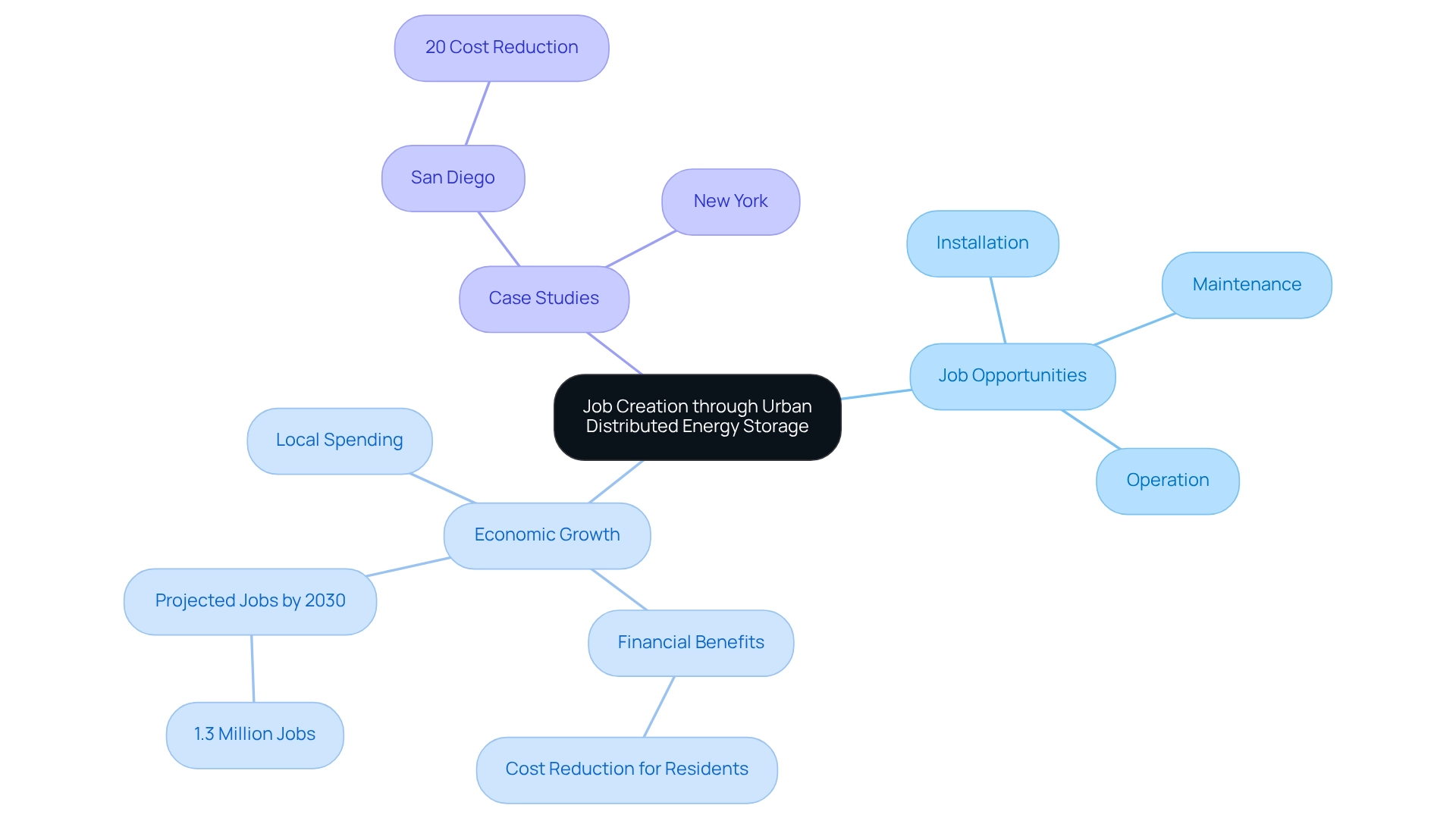
Strategic Impact: Transforming Urban Energy Landscapes with Distributed Energy Storage
Urban distributed energy storage systems are set to revolutionize power landscapes, promoting resilient, efficient, and sustainable urban environments. By integrating urban distributed energy storage systems into urban planning, cities can significantly enhance their power reliability, lower greenhouse gas emissions, and encourage the use of renewable energy sources. This strategic transition not only addresses pressing power challenges but also equips cities for a sustainable energy future.
Recent initiatives, exemplified by the Solar Energy Industries Association's (SEIA) ambitious target to deploy 10 million distributed installations and achieve a total installed capacity of 700 GWh by 2030, highlight the economic and energy security importance of a robust sector. The SEIA whitepaper outlines critical policy recommendations, including:
- The preservation of federal tax credits
- The assurance of equitable grid access
These are essential for advancing energy capacity development. Notably, it is projected that at least 35% of the benefits from new power retention initiatives, particularly through urban distributed energy storage systems, will reach underserved communities, ensuring equitable access to technological advancements.
As cities increasingly integrate distributed power solutions into their planning frameworks, they are witnessing transformative impacts. For instance, New York's regulatory landscape mandates rigorous safety assessments for energy conservation technologies, reflecting a commitment to safety and reliability. Governor Kathy Hochul emphasized this commitment, asserting that such measures are vital as metropolitan areas adapt to the rising demand for energy resilience. This proactive approach is crucial for ensuring that power retention frameworks are both effective and secure within urban settings.
Moreover, the 2024 Energy Retention Order Overview outlines significant project financing and criteria, establishing a foundation for enhanced retention development. By strategically incorporating urban distributed energy storage systems, cities can not only bolster their resource security but also cultivate a more sustainable and equitable future for all residents.
For Directors of Land Acquisition, grasping these dynamics is essential, as the integration of energy storage systems can significantly influence land acquisition strategies and zoning regulations, ultimately shaping the future of urban energy landscapes.
Conclusion
Urban distributed energy storage systems are essential for transforming energy landscapes, enhancing energy security, and facilitating the integration of renewable sources. By serving as buffers during peak demand, these systems not only improve reliability but also enable local energy independence, fostering resilience against fluctuating prices. Technological advancements, such as artificial intelligence, further optimize energy management, thereby maximizing efficiency.
The economic advantages are noteworthy. These systems lower energy costs and create job opportunities within the clean energy sector, stimulating local economies and contributing to sustainability goals. As cities adopt these technologies, they effectively meet energy demands while enhancing community well-being.
Navigating the regulatory landscape is critical for successful implementation. Supportive policies and strategic planning are vital to unlocking the full potential of distributed energy storage, ensuring equitable access for all communities. Recent initiatives highlight the importance of integrating these systems into urban planning as a pathway for economic growth and sustainable development.
In conclusion, urban distributed energy storage systems represent a transformative approach to energy management. By investing in these technologies, cities can achieve enhanced energy security, reduced carbon footprints, and empowered communities, paving the way for a cleaner and more equitable future.
Frequently Asked Questions
What services does Harbinger Land provide for power and infrastructure projects?
Harbinger Land offers tailored land services including site and right-of-way acquisition, title research, GIS mapping, and advanced data processing.
How does Harbinger Land enhance operational efficiency for clients?
By leveraging integrated GIS modeling services, Harbinger Land efficiently negotiates and acquires necessary leases and easements, improving operational efficiency and client satisfaction.
What challenges do developers face in land acquisition for distributed power facilities?
Developers often encounter delays due to complex regulatory requirements and the average distance from city-based distributed power facilities to protected areas, which complicates land acquisition.
How do comprehensive land services benefit power projects?
Comprehensive land services streamline land acquisition processes and ensure compliance with zoning regulations and environmental considerations, thereby bolstering project viability.
What role does technology play in Harbinger Land's services?
The integration of technology, such as document imaging solutions, enhances the efficiency of title research and leasing, providing quick access to extensive datasets for informed decision-making.
Why are effective land management strategies important for sustainable development?
Effective land management strategies consider the interconnections between food production, power generation, and water resources, which are essential for sustainable development.
What is the significance of urban distributed energy storage systems?
Urban distributed energy storage systems help reduce carbon emissions, promote renewable energy integration, and provide stored energy during high demand, diminishing reliance on fossil fuels.
How do urban distributed energy storage systems contribute to cost savings?
By storing power during off-peak hours and discharging it during peak hours, these systems flatten costs, reducing the need for expensive peak power facilities and leading to overall savings in utility expenses.
What impact do urban distributed energy storage systems have on land acquisition strategies?
As decision-makers recognize the benefits of renewable solutions, urban distributed energy storage systems influence land acquisition strategies in urban planning, facilitating the integration of these systems into city initiatives.
List of Sources
- Harbinger Land: Comprehensive Solutions for Land Services in Energy and Infrastructure
- pnas.org (https://pnas.org/doi/10.1073/pnas.1517656112)
- Read "The Power of Renewables: Opportunities and Challenges for China and the United States" at NAP.edu (https://nap.nationalacademies.org/read/12987/chapter/6)
- Environmental Sustainability: Reducing Carbon Footprint with Urban Distributed Energy Storage
- Energy Storage (https://ucsusa.org/resources/how-energy-storage-works)
- Solar Energy and Battery Storage | Energy Storage (https://pfisterenergy.com/service/solar-energy-storage-systems)
- Energy Reliability: Enhancing Grid Stability with Urban Distributed Energy Storage
- Hitachi's Energy Storage System for a Cleaner Future (https://social-innovation.hitachi/en-us/case_studies/energy_crystena)
- GLOW: Helping California to a Brighter Future Using Clean Energy (https://social-innovation.hitachi/en-us/case_studies/glow-helping-clean-energy-transition-for-california)
- Powering Tower Cranes With Battery Energy Storage Systems – Blue Diamond Solution (https://solutions.bluedm.com.au/case_studies/powering-tower-cranes-with-the-ampd-enertainer-battery-energy-storage-system)
- Renewable Integration: Facilitating the Use of Solar and Wind Energy in Urban Areas
- Future-proofing U.S. embassies and consulates (https://news.northwestern.edu/stories/2024/10/future-proofing-us-embassies-and-consulates)
- Can a City Be Sustainable? (State of the World) (https://islandpress.org/books/can-city-be-sustainable-state-world?type=All)
- Technological Innovation: Smart Solutions for Urban Distributed Energy Storage
- Machine learning-based energy management and power forecasting in grid-connected microgrids with multiple distributed energy sources - Scientific Reports (https://nature.com/articles/s41598-024-70336-3)
- Top 10 applications of AI in the energy sector | FDM Group (https://fdmgroup.com/news-insights/ai-in-energy-sector)
- Optimize Efficiency With AI-Driven Energy Management (https://pecan.ai/blog/optimize-efficiency-with-ai-energy-management)
- Community Empowerment: Promoting Local Energy Independence with Distributed Storage
- SERENE project advances local energy systems across Europe (https://innovationnewsnetwork.com/serene-project-advances-local-energy-systems-across-europe/50650)
- Local Energy Communities in Spain: Economic Implications of the New Tariff and Variable Coefficients (https://mdpi.com/2071-1050/13/19/10555)
- Empowering people – the role of local energy communities in clean energy transitions – Analysis - IEA (https://iea.org/commentaries/empowering-people-the-role-of-local-energy-communities-in-clean-energy-transitions)
- Regulatory Support: Navigating Policies for Urban Distributed Energy Storage Implementation
- Energy Transition in Latin America and the Caribbean (https://iadb.org/en/news/energy-transition-latin-america-and-caribbean)
- Grid connection backlog grows by 30% in 2023, dominated by requests for solar, wind, and energy storage | Energy Markets & Policy (https://emp.lbl.gov/news/grid-connection-backlog-grows-30-2023-dominated-requests-solar-wind-and-energy-storage)
- Energy Storage (https://cpuc.ca.gov/industries-and-topics/electrical-energy/energy-storage)
- Job Creation: Boosting Local Economies through Urban Distributed Energy Storage Projects
- World Energy Transitions Outlook 2023 (https://irena.org/Digital-Report/World-Energy-Transitions-Outlook-2023)
- Strategic Impact: Transforming Urban Energy Landscapes with Distributed Energy Storage
- SEIA Announces Target of 700 GWh of U.S. Energy Storage by 2030 – SEIA (https://seia.org/news/seia-announces-target-of-700-gwh-of-u-s-energy-storage-by-2030)
- nyserda.ny.gov (https://nyserda.ny.gov/All-Programs/Energy-Storage-Program)




